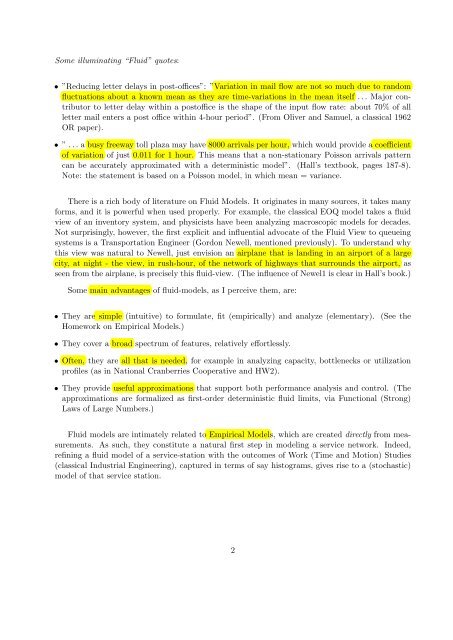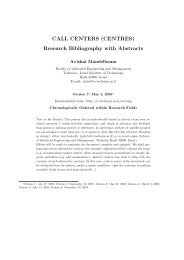PDF-6.4MB - Faculty of Industrial Engineering and Management
PDF-6.4MB - Faculty of Industrial Engineering and Management
PDF-6.4MB - Faculty of Industrial Engineering and Management
Create successful ePaper yourself
Turn your PDF publications into a flip-book with our unique Google optimized e-Paper software.
Some illuminating “Fluid” quotes:<br />
• ”Reducing letter delays in post-<strong>of</strong>fices”: ”Variation in mail flow are not so much due to r<strong>and</strong>om<br />
fluctuations about a known mean as they are time-variations in the mean itself . . . Major contributor<br />
to letter delay within a post<strong>of</strong>fice is the shape <strong>of</strong> the input flow rate: about 70% <strong>of</strong> all<br />
letter mail enters a post <strong>of</strong>fice within 4-hour period”. (From Oliver <strong>and</strong> Samuel, a classical 1962<br />
OR paper).<br />
• ” . . . a busy freeway toll plaza may have 8000 arrivals per hour, which would provide a coefficient<br />
<strong>of</strong> variation <strong>of</strong> just 0.011 for 1 hour. This means that a non-stationary Poisson arrivals pattern<br />
can be accurately approximated with a deterministic model”. (Hall’s textbook, pages 187-8).<br />
Note: the statement is based on a Poisson model, in which mean = variance.<br />
There is a rich body <strong>of</strong> literature on Fluid Models. It originates in many sources, it takes many<br />
forms, <strong>and</strong> it is powerful when used properly. For example, the classical EOQ model takes a fluid<br />
view <strong>of</strong> an inventory system, <strong>and</strong> physicists have been analyzing macroscopic models for decades.<br />
Not surprisingly, however, the first explicit <strong>and</strong> influential advocate <strong>of</strong> the Fluid View to queueing<br />
systems is a Transportation Engineer (Gordon Newell, mentioned previously). To underst<strong>and</strong> why<br />
this view was natural to Newell, just envision an airplane that is l<strong>and</strong>ing in an airport <strong>of</strong> a large<br />
city, at night - the view, in rush-hour, <strong>of</strong> the network <strong>of</strong> highways that surrounds the airport, as<br />
seen from the airplane, is precisely this fluid-view. (The influence <strong>of</strong> Newel1 is clear in Hall’s book.)<br />
Some main advantages <strong>of</strong> fluid-models, as I perceive them, are:<br />
• They are simple (intuitive) to formulate, fit (empirically) <strong>and</strong> analyze (elementary). (See the<br />
Homework on Empirical Models.)<br />
• They cover a broad spectrum <strong>of</strong> features, relatively effortlessly.<br />
• Often, they are all that is needed, for example in analyzing capacity, bottlenecks or utilization<br />
pr<strong>of</strong>iles (as in National Cranberries Cooperative <strong>and</strong> HW2).<br />
• They provide useful approximations that support both performance analysis <strong>and</strong> control. (The<br />
approximations are formalized as first-order deterministic fluid limits, via Functional (Strong)<br />
Laws <strong>of</strong> Large Numbers.)<br />
Fluid models are intimately related to Empirical Models, which are created directly from measurements.<br />
As such, they constitute a natural first step in modeling a service network. Indeed,<br />
refining a fluid model <strong>of</strong> a service-station with the outcomes <strong>of</strong> Work (Time <strong>and</strong> Motion) Studies<br />
(classical <strong>Industrial</strong> <strong>Engineering</strong>), captured in terms <strong>of</strong> say histograms, gives rise to a (stochastic)<br />
model <strong>of</strong> that service station.<br />
2
















